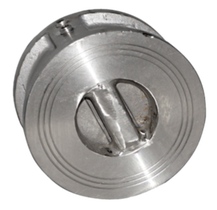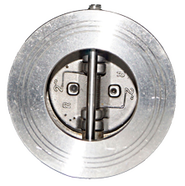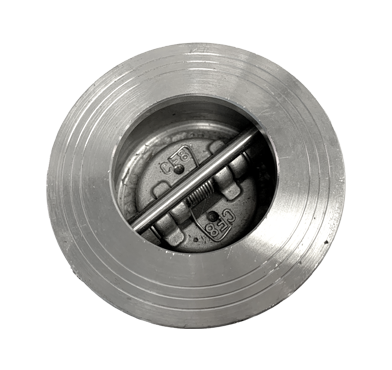|
|
Dual plate check valves are also known as retainerless check valves or non-return valves. The dual plate check valve is a low pressure valve made following the API 594 standards. After production, the dual plate check valves are tested using the API 598 standards. The valve is similar to the single plate check valve, however, it differs in weight and slam level. The valve is used in systems to allow the flow of fluids in one direction and prevent the backflow of fluids. The dual plate check valve is made from stainless steel (CF8M) and can withstand a maximum working pressure of 300 PSI. The available sizes range from 1 1/2” to 6”. Dual plate check valve various end connection types. |
Material Specification |
|
Connection Type |
|
Size |
|
Working Pressure |
|
1. What are Dual Plate Check Valves?
|
Check valves are two-port valves that allow the flow of fluids to pass through one direction. These valves are commonly used for different purposes in industries, and one major feature distinguishes the check valve from others, they help prevent the backflow of fluids. There are several types of check valves, some are ball check valve, swing check valve, single plate check valves, dual plate check valves, etc. Also, check valves are operated automatically without operators' need while passing or preventing the backflow of fluids.
Dual plate check valves are also referred to as non-return valves or retainerless valves. It is used in installations to prevent the backflow of fluids and contaminants to water systems. The dual plate check valve is designed in a wafer structure which makes it more compact and light-weighted. Dual plate check valves are produced following the API 594 standards. The valve has a retainerless design that makes the installation of hinge-pin and stop-pin possible without a full drill on the valve's body. The dual plate check valve has a valve plate place on the raised valve seat. The valve plate has an important role in ensuring the valve plate correlates with the position of the valve seat. |
Dual plate check valves are applied in a wide variety of industries. Some of these include:
- Water Systems: dual plate check valves are applied in water supply systems, potable water, cooling water, seawater, and boiler feed water.
- Chemical appliances: the valves are applied in Zinc, Copper, Pharmaceutical, sugar process, cement, and paper production.
- Oil and Gas: they are used in lubricating oil, Cryogenic, LNG, Onshore and Offshore, Petroleum, and Sour gas low-temperature systems.
- Air and Gases: they can be used with productions involving Chlorine, Oxygen, Carbon dioxide, Nitrogen, and Hydrogen.
2. What materials are Dual Plate Check Valves made of?
|
The dual plate check valves are made from stainless steel and CF8M materials. Stainless steel is a common material used in the production of several appliances, including pipes, tubes, valves, fittings, hoses, etc. Stainless steel SS316 contains various elements, including chromium, which contributes to its corrosion resistance feature.
CF8M is an austenitic stainless steel material that has a molybdenum element added to it. The addition of molybdenum increases the corrosion resistance. The seat ring of the valve is available in NBR or stainless steel. The size of the valve ranges from 1 1/2” to 6”. And the maximum working pressure is 300 PSI. |
The table below shows the component material of the dual plate check valves:
|
3. How does a Dual Plate Check Valve work?
|
The dual plate valve allows the flow of fluid in. one direction. When the fluid flow goes through an alternate direction, the pressure and plate influence on the seat, the flow stops. The reducing flow then allows the valve plate to close by the torsion spring activity. This happens without the backflow of fluid.
The valve has an even stress distribution because of the cylindrical body shape. This is an advantage over other valves design. The valve also has an edge over others to accommodate the maximum weight and thickness of the valve. This increases its safety during use and cost-effectiveness. |
4. What is a non-slam check valve?
|
The dual plate check valve is designed so that there’s no slamming and water hammering occurrences whatsoever. The common problem with check valves is the slamming effect. Unlike the single plate check valve, the dual plate check valve is referred to as a non-slam check valve due to the improvements in its features. These two problems could lead to damage to the system or reduced efficiency of the valve.
The valve's swing plate is joined at the top of the valve, and the gravitational force has high inactivity while dangling to the closing position. If this doesn’t occur, the damage will occur during slamming. The plates are joined at the center of the valve vertically for a horizontal connection. This connection removes any gravitational effect on the valve. |
5. What are the benefits of using Dual Plate Check Valves?
|
Some of the advantages of using a dual plate check valve are discussed below:
|
6. How can Dual Plate Check Valves be installed?
STEP 1: Cleaning of the valve
During production, the ends of the dual plate check valves are rubbed with rust proofing oil. After purchase, ensure you thoroughly clean the ends and the rustproof oils. Before installation, the dual plate check valve plate must be free from any oil, rust, or other substances that could contaminate the fluids.
STEP 2: Choose the flow direction
On the dual plate check valve body, an arrow to indicate the flow direction is stamped on it. This will guide you when installing as the flow direction chosen must align with the arrow indication on the valve body.
STEP 3: Insert the dual plate check valve in a horizontal piping system
After the flow direction has been rightly chosen, the next step is to place the check valve in the piping system. Please note that the pin retainers should be inserted in an up and down position during installation.
STEP 4: Measure the gap between the dual plate check valve and flange
After inserting the valve in a horizontal direction, you have to measure the distance between the dual plate check valve and the flange. Ensure there’s enough space created between these two devices.
You have to bear in mind that only proper installation and maintenance will improve the dual plate check valves' efficiency and performance.
During production, the ends of the dual plate check valves are rubbed with rust proofing oil. After purchase, ensure you thoroughly clean the ends and the rustproof oils. Before installation, the dual plate check valve plate must be free from any oil, rust, or other substances that could contaminate the fluids.
STEP 2: Choose the flow direction
On the dual plate check valve body, an arrow to indicate the flow direction is stamped on it. This will guide you when installing as the flow direction chosen must align with the arrow indication on the valve body.
STEP 3: Insert the dual plate check valve in a horizontal piping system
After the flow direction has been rightly chosen, the next step is to place the check valve in the piping system. Please note that the pin retainers should be inserted in an up and down position during installation.
STEP 4: Measure the gap between the dual plate check valve and flange
After inserting the valve in a horizontal direction, you have to measure the distance between the dual plate check valve and the flange. Ensure there’s enough space created between these two devices.
You have to bear in mind that only proper installation and maintenance will improve the dual plate check valves' efficiency and performance.
DUAL PLATE CHECK VALVE CATALOGUE










